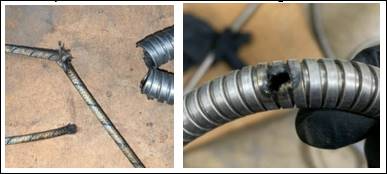
We were contacted by a customer a few weeks ago with concerns about our heaters failing quickly – they were shorting out in the BX cable – near the junction box. Why heaters were failing in the lead wire 6-18” from the junction box was a mystery.
The customer was growing more frustrated by the hour demanded an immediate explanation and a visit to assess the situation. Without hesitation, we set out to visit this important customer. The findings from the visit were both illuminating and instructional for us in the heating business.
Electrical blow-out of the BX and lead wire.

Heater with blue discoloration and white coating on tray ready for insertion.

During the visit, engineering confirmed only 2 of 12 production lines were having higher failures. The lead wire and BX were 84” long and were coiled resting on a sheet metal tray that served as mount for junction box and water cooling quick disconnect. In addition, molding material coated the tooling frame, cables and BX. Maintenance further admitted that some of the coiled BX was resting in standing water from leaking cooling water quick disconnects.
In the maintenance shop, the heater pictured above could not be pulled out of the tool without pliers. The end near the header was blue from over-heating and a white residue of lubricant was visible. The tool was originally drilled to 0.503” but contamination and build-up reduced the effective diameter. Maintenance procedures called for cleaning bores prior to installing heaters with a 0.495” reaming tool.
We identified a list of things that contributed to the heater failures:
- Lead too long – Right length of lead wire and BX
- Leads in water – Hanger to get BX off the ground
- Bore too tight – 0.015” over nominal heater size and matching reamer
- Heater too hot – Added Cold-end near thin wall of tool
- Header prevented expansion – Eliminated weld around
- Lubricant added – NEVER USE paste, anti-seize
- Hammer in heaters – Right bore will stop need for hammering in heaters
As with most failures, they stem from a series of minor failures that add up to a big problem. We hope you gain as much as we did from this article.
